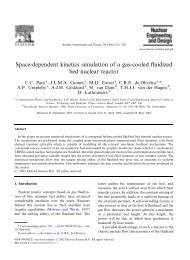Chapter 8 Configuring Fluidity - The Applied Modelling and ...
Chapter 8 Configuring Fluidity - The Applied Modelling and ...
Chapter 8 Configuring Fluidity - The Applied Modelling and ...
Create successful ePaper yourself
Turn your PDF publications into a flip-book with our unique Google optimized e-Paper software.
2 Getting started<br />
You can download just the source, or you can download extra archives containing examples, st<strong>and</strong>ard<br />
tests, <strong>and</strong> long tests.<br />
To uncompress the <strong>Fluidity</strong> 4.0-release source from an archive file in Linux, run:<br />
tar -zxvf fluidity-4.0.tar.gz<br />
This should create a directory, fluidity-4.0/, containing your copy of the source code. To add<br />
examples, st<strong>and</strong>ard tests, or long tests, download the relevent archive into the fluidity-4.0/<br />
directory, <strong>and</strong> in that directory run (in the case of examples):<br />
tar -zxvf fluidity-examples-4.0.tar.gz<br />
<strong>The</strong> files will appear in an examples/ directory in this case, or for st<strong>and</strong>ard tests tests/ <strong>and</strong> long<br />
tests longtests/.<br />
1.2.3 Subversion<br />
For experienced subversion users, the relevant information that you need to obtain<br />
a copy of <strong>Fluidity</strong> is that it the latest development version is available from<br />
http://amcg.ese.ic.ac.uk/svn/fluidity/trunk . For inexperienced users, or those<br />
wanting a more stable version than the development trunk, please read on to learn how to obtain a<br />
copy of <strong>Fluidity</strong>.<br />
As a <strong>Fluidity</strong> user you need only be aware of two modes of operation that subversion has. <strong>The</strong> first is<br />
checking out a copy of the source code from the central repository, the second is updating your copy<br />
of the code to reflect changes that have been made to the central repository. Think of the repository<br />
as a central archive of source code held on the main <strong>Fluidity</strong> servers.<br />
<strong>The</strong>re are a few other useful features for users which subversion has which will be mentioned in<br />
passing.<br />
Details of how to commit changes to <strong>Fluidity</strong> back into the central repository are outside the scope<br />
of this user manual; if you are transitioning to become a developer who commits changes back into<br />
<strong>Fluidity</strong> please contact an existing <strong>Fluidity</strong> developer to find out how to get commit privileges.<br />
A point of terminology - tags will be referred to throughout this section. Think of these as index<br />
entries which point to specific versions of <strong>Fluidity</strong>. Some are permanent, some periodically change<br />
to point do different positions.<br />
1.2.3.1 Checking out a current copy of <strong>Fluidity</strong><br />
<strong>Fluidity</strong> can be obtained in three forms: release, stable, <strong>and</strong> trunk.<br />
<strong>The</strong> first, release, is aimed at general users of <strong>Fluidity</strong>. Releases have unique, tagged version numbers,<br />
<strong>and</strong> an individual version tag will never change content. New versions will be produced whenever<br />
there is sufficient dem<strong>and</strong> for new features to be included. It is very well tested <strong>and</strong> does not contain<br />
any code known to have bugs. As such, code under development may be removed, <strong>and</strong> the latest<br />
features may not be present. <strong>The</strong> manual <strong>and</strong> other resources are written to support release.<br />
<strong>The</strong> second, stable, is aimed at users who require access to development code but do not wish to be<br />
exposed to the frequent but transitory issues that tend to occur in bleeding-edge <strong>Fluidity</strong>. Nothing<br />
is removed from stable, but it is only updated when all tests within <strong>Fluidity</strong> pass. It will generally<br />
be updated on a weekly to fortnightly basis, but may go longer between updates during periods of<br />
particularly intense development. <strong>The</strong>re are no guarantees that subtle bugs will not make it through<br />
to stable, nor that all features present are fully functional. <strong>The</strong> manual may not be fully up to date<br />
for stable.




